The Program Configurations Analysis Templates module provides the capability to configure statistical calculation options specific to each analysis run for a program. Within this module, depending on assigned role, users are able to do the following:
- Create, view, edit, duplicate, enable/disable, and delete templates
- Apply templates to selected test(s) under the specified program
- Configure default Statistics Tags
The combination of what is configured in the Analysis Template and Test Settings is what drives each analysis in a request.
To navigate to the Analysis Templates module, from the Main Navigation toolbar select Configurations and then Analysis Templates.
- All PAR users with access to the program selected will be able to view analysis templates
- Super Admins and PAR Admins for the program selected are able to perform all actions available for analysis templates

Selecting Analysis Templates will display a list of analysis templates for the program selected in Global Navigation.
- The default sort order of templates is alphabetical by template Name
- Each column is able to be filtered for different values.
- Program - program code
- Hovering over the value in the Program column will display the full program name
- If a user has access to more than one program, the column filter can be cleared/modified to display templates from multiple programs. The only actions available, for templates that are from a program other than the one selected in Global Navigation, are view and duplicate (if the user has required permissions)
- If templates from more than one program are displayed, the default sort order is alphabetical by Program and then by Name
- Name - a user-provided template name (cannot be changed after saving)
- Description - a user-provided template description
- Analysis Type - Item Analysis - Classical, Item Analysis - Differential Item Functioning, or Summary Statistics (more to come...)
- Test(s) - test codes for any tests applied to the template
- If the list of the test codes becomes too long for one line, a 'See More' link will be provided to show the full list
- Status - Draft or Approved
- Only Approved templates will be shown in Test Settings and be able to be selected in Ad-Hoc Analyses
- Enabled/Disabled - only Enabled templates will be shown in Test Settings and be able to be selected in Ad-Hoc Analyses
- Actions - this column is only displayed for Super Admins and PAR Admins of the program selected in Global Navigation. Actions include:
- Edit, Duplicate, More...
- Apply Tests
- Disable (changed to Enable if a template is Disabled)
- Delete
- Edit, Duplicate, More...
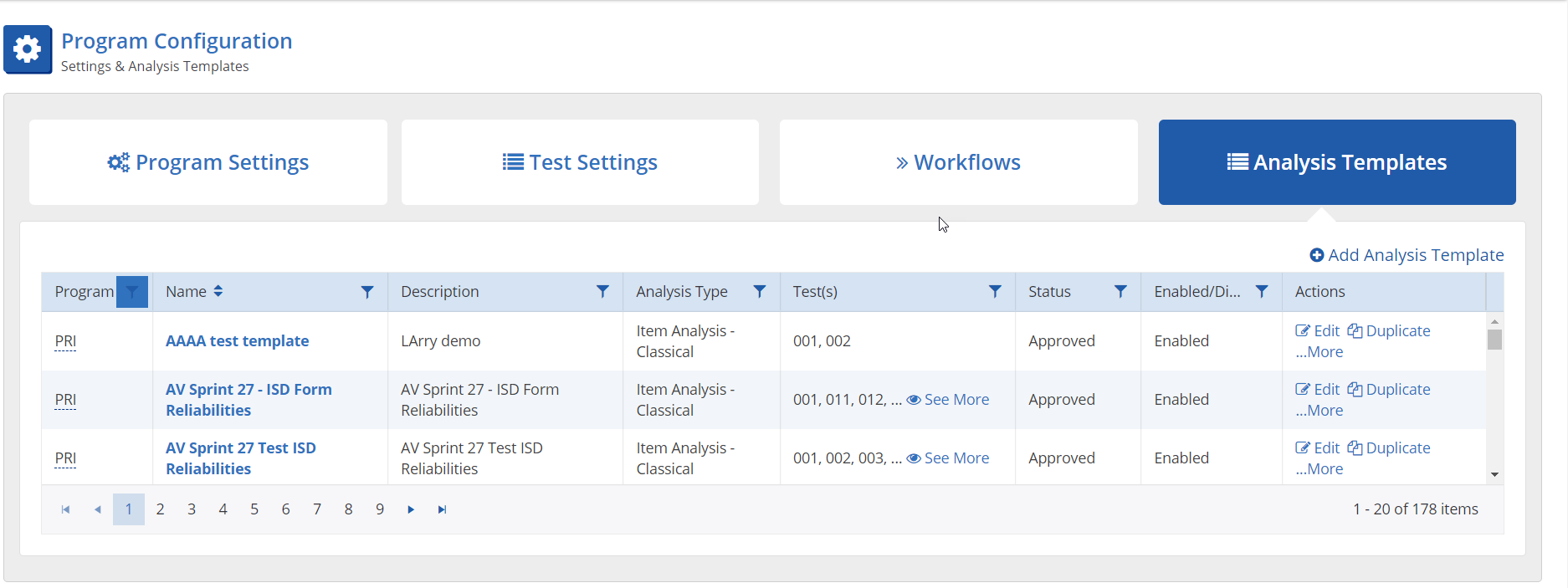
Creating an Analysis Template
Users with Super Admin or PAR Admin role for the program selected in Global Navigation will be able to create an analysis template. The + Add Analysis Template link will be available in the top right of the table.
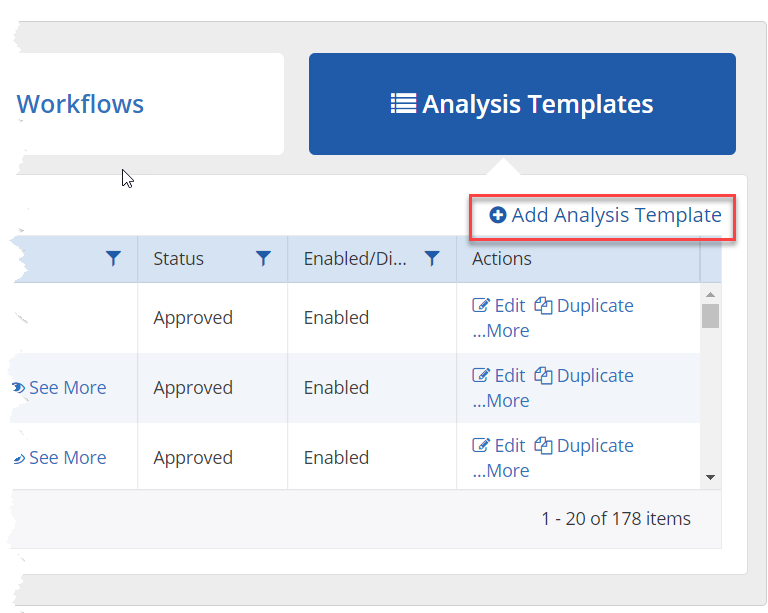
Selecting the + Add Analysis Template link will open a screen to create a new template.
(Note: If no Test-Taker Selection Queries have been configured yet for the program, a message will display that says 'Queries need to be configured for the program before creating Analysis Templates" followed by a link to Queries.)
There are two tabs, Analysis Template and Statistics Tags (disabled until all required fields are completed in the Analysis Template tab)In the Analysis Template tab:
- Program - pre-populated with the program selected in Global Navigation
- Name - enter a unique template name
- If a template name is entered that already exists for the program, a message will display that says: 'Analysis template name already exists for program {program code - program name}', and Save will be disabled.
- Description - enter a description for the template
- Analysis Type - single-select drop down with all available analysis types listed in alphabetical order. Currently, this includes:
- Item Analysis - Classical
- Item Analysis - Differential Item Functioning
- Summary Statistics
- Test Taker Selection Query - single-select drop down (with search feature) that includes all Test Taker Selection queries configured for the program
- Query type must be Test Taker Selection
- Available values displayed in alphabetical order
- See Queries for additional details
Item Analysis - Classical
Item Analysis - Differential Item Functioning
Summary Statistics
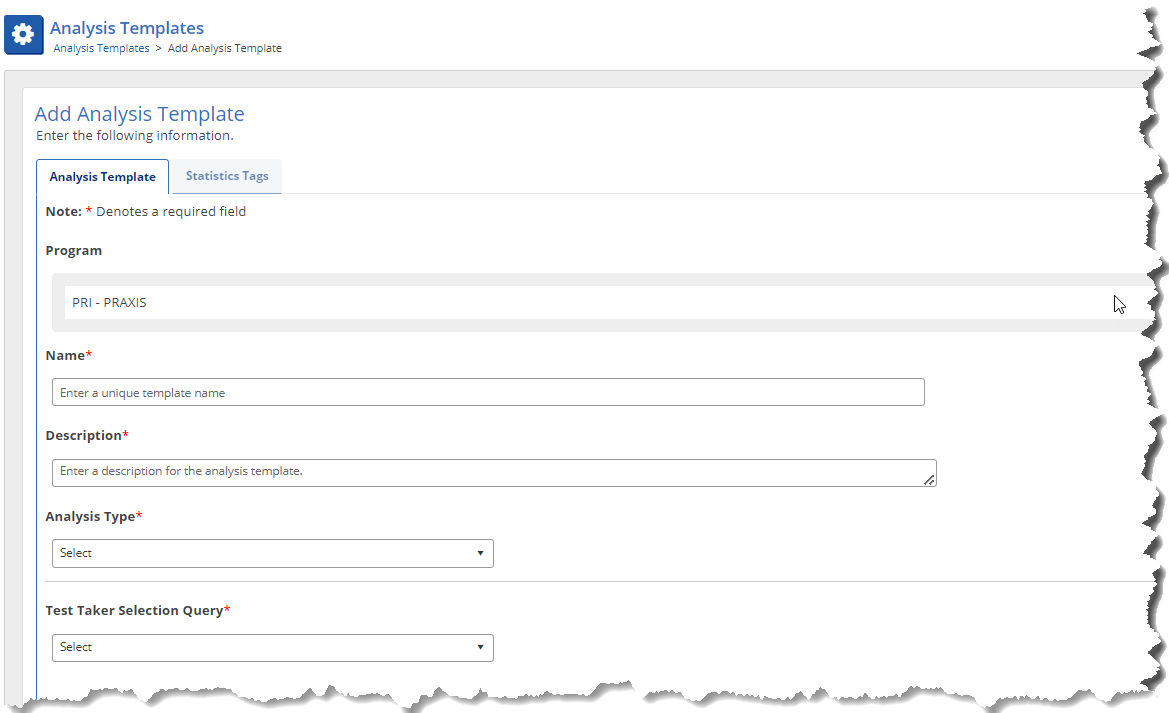
Once all required selections in the Analysis Template tab have been entered, the Statistics Tags tab becomes available. Please see specific template types for Statistics Tags options.
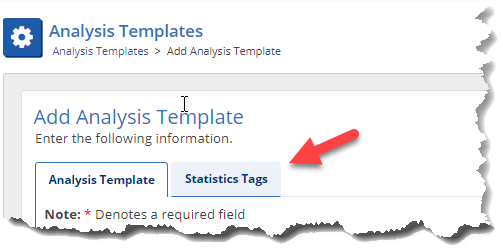
Saving an Analysis Template
Once all required selections have been made ‘Save’ becomes enabled.
- Saving an analysis template will put it in Draft and Enabled status.
- Once a template is reviewed, it should be approved to be able to configure Test Settings and be used in analysis requests.
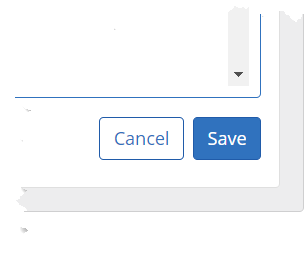
Viewing an Analysis Template
All PAR users with access to the program selected in Global Navigation will be able to view analysis templates.
To view, select a template Name hyperlink.

Selecting a template Name hyperlink will open the template in view mode.
- There are three tabs, Analysis Template , Statistics Tags and Audit.
- The window defaults to the Analysis Template tab.
In the Analysis Template tab, the following is displayed:
- Program
- Name
- Status
- Enabled/Disabled
- Description
- Analysis Type
- Test Taker Selection Query and Query Expression
- Test(s) applied to this template
- All configured options
Item Analysis - Classical
Item Analysis - Differential Item Functioning
Summary Statistics
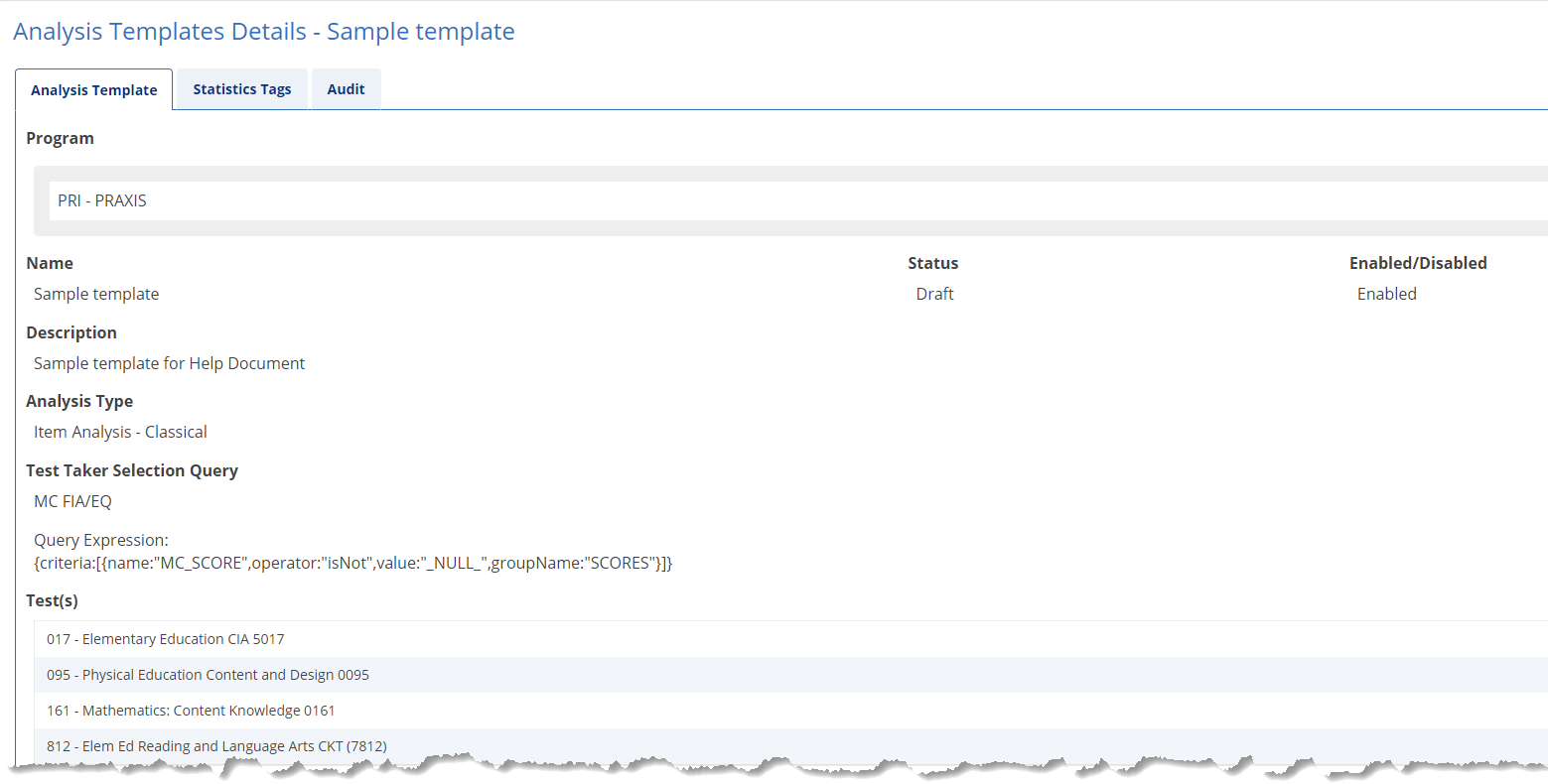
In the Statistics Tags tab:
- Check marks show default item-level and/or test-level tag selections configured during template creation.
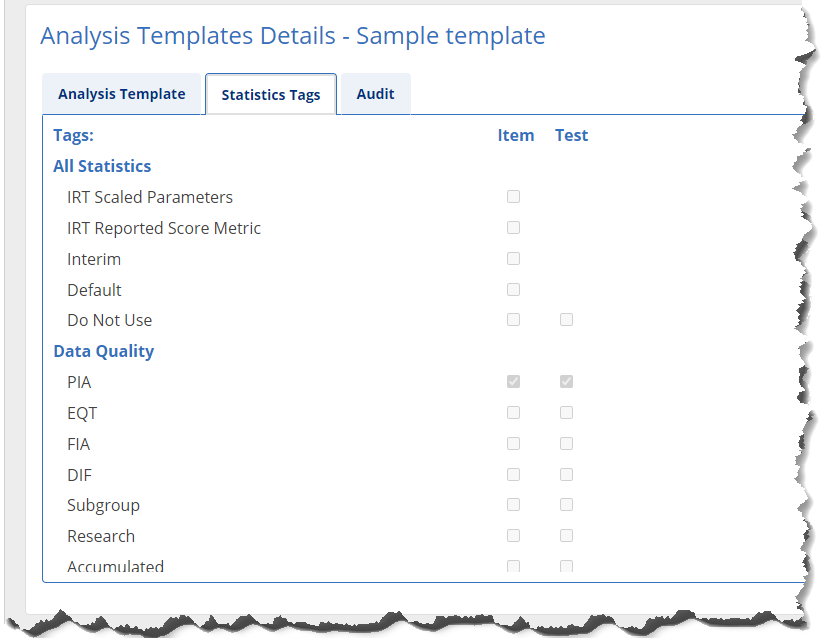
In the Audit tab:
- A table displays most changes made to the template, including the following:
- Template creation and approval
- Updates to option choices
- Updates to description
- Updates to Statistics tags
- Columns include: Date & Time, Event and Username.
- Columns can be sorted and filtered.
- An ‘Export List’ link is available to download the audit list to an Excel or CSV file.

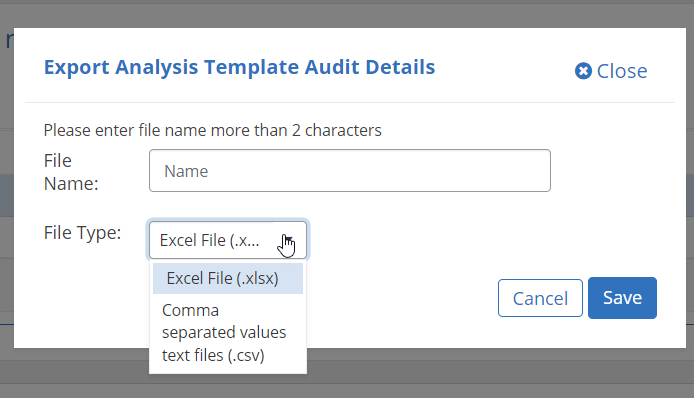
While in View mode you can navigate to other templates, or select the breadcrumb 'Analysis Templates' to return to the list of templates for the selected program.

Approving an Analysis Template
** Templates need to be in Approved status to configure Test Settings and to be used in analysis requests.**
Users with Super Admin or PAR Admin roles for the selected program are able to approve a template.
To approve a template:
- View the details of the analysis template by selecting the template Name hyperlink (as detailed above under "Viewing an Analysis Template").
- The 'Approve' button will be displayed in the right-hand bottom corner of the template if the user has the required role.
- The 'Approve' button will be enabled if:
- The template is in Draft and Enabled status
- The template is under the program selected in Global Navigation
- The 'Approve' button will be enabled if:
- Selecting 'Approve' will automatically move the template to Approved status and return you to the Analysis Template grid where the status of the selected template will be updated to 'Approved'
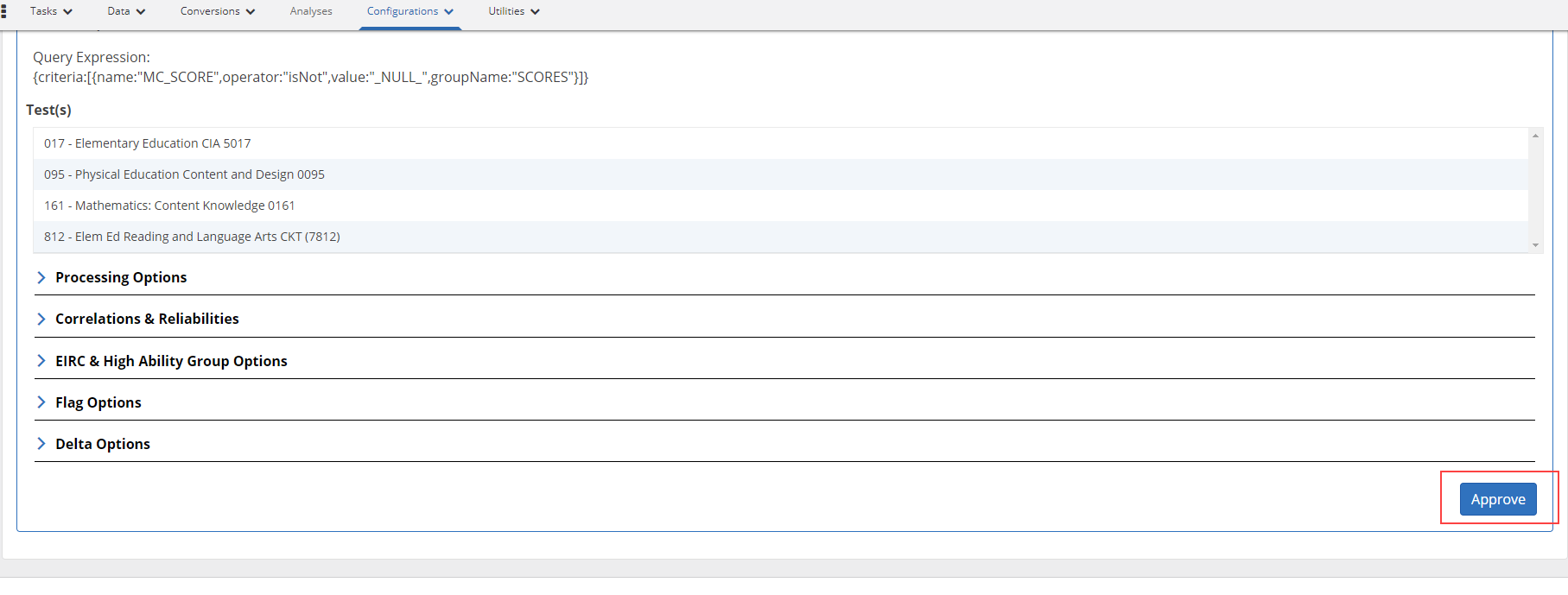
Users with Super Admin or PAR Admin role for the program selected in Global Navigation will be able to edit an analysis template.
To edit a template, select ‘Edit’ in the Actions column
Notes: Option will be disabled for a disabled template, and will not appear for a template associated to a different program than the one selected in Global Navigation.

If editing an Approved template, the status will automatically move back to Draft.
A warning banner will display with the following message 'Editing an Approved template will automatically change the status back to Draft and impact Test Settings for the applied tests."

- All fields in the Analysis Template tab and Statistics tab can be edited with the exception of:
- Program
- Name
- Analysis Type
- Applied Tests (can be updated through the Actions menu in the Analysis Templates grid)
For specific option details for each Analysis Type see:
Item Analysis - Classical
Item Analysis - Differential Item Functioning
Summary Statistics
Item Analysis - Classical
Item Analysis - Differential Item Functioning
Summary Statistics
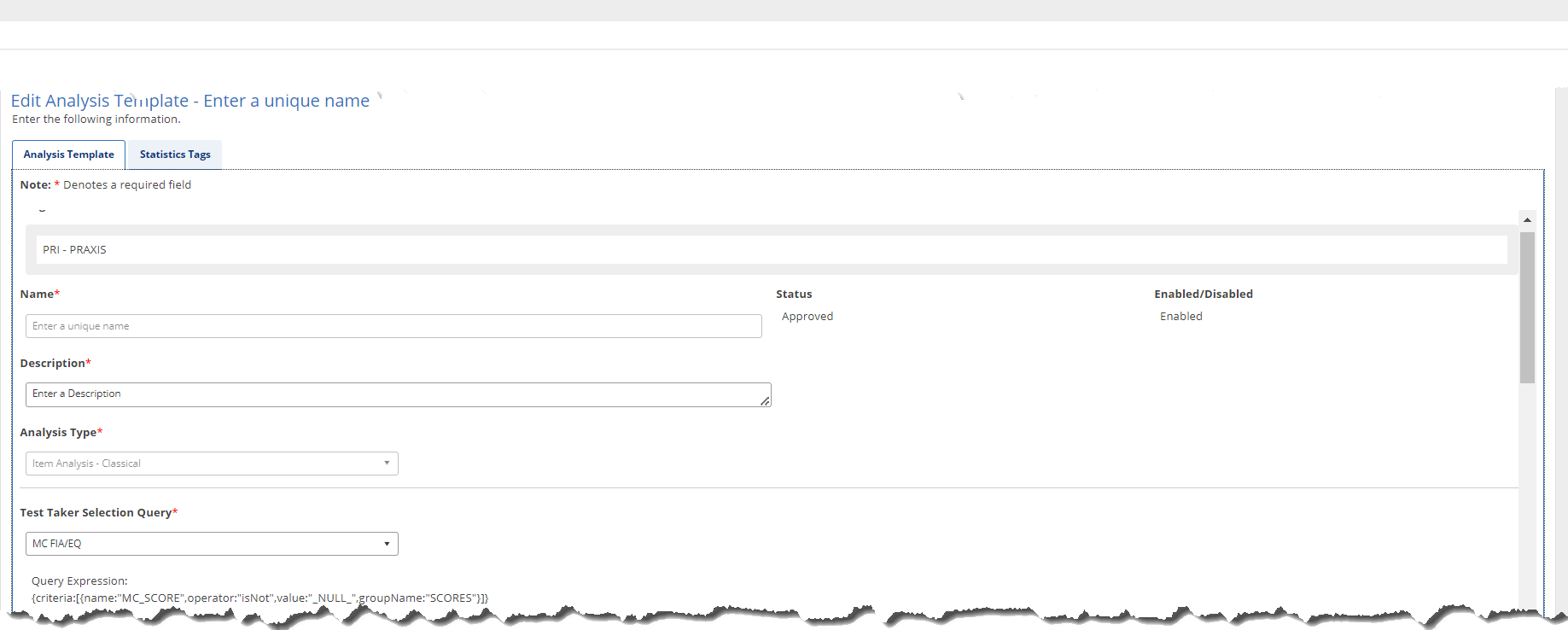
Duplicating an Analysis Template
Users with Super Admin or PAR Admin role for the program selected in Global Navigation will be able to duplicate an analysis template.
A Super Admin, or a PAR Admin user with access to more than one program, can duplicate a template from one program to another by modifying/clearing the Program filter. For any program(s) not selected in Global Navigation, 'Duplicate' will be the only option that appears under the Actions column.
Users can duplicate templates that are Approved or Draft, as well as Enabled or Disabled.
When a duplicated template is saved, it is automatically set to Draft and Enabled status.
To duplicate a template, select ‘Duplicate’ in the Actions column.
Duplicating within the same program

Duplicating across programs

When duplicating across programs, the new template is saved under the program selected in Global Navigation.
Everything from the Analysis Template tab and the Statistics Tags tab are copied to the new template.
- Name is appended with "- Copy"
- Program
- Analysis Type
- Applied Tests (can be updated through the Actions menu in the Analysis Templates grid)
- Applied tests are not copied over from the original template
Item Analysis - Classical
Item Analysis - Differential Item Functioning
Summary Statistics
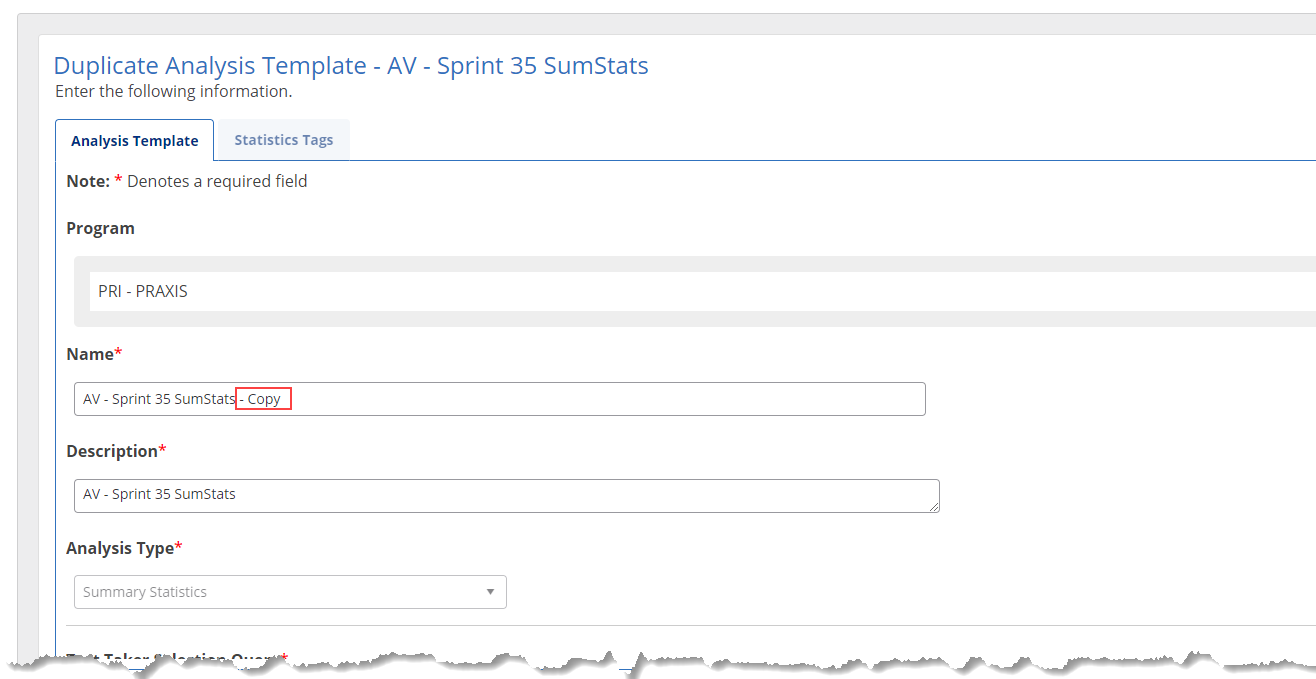
Upon saving a duplicated template, the status defaults to Draft and Enabled.
Applying Test(s) to an Analysis Template
Users with Super Admin or PAR Admin role for the program selected in Global Navigation will be able to apply tests to an analysis template under the selected program.
- Tests can be applied to both Draft and Approved templates without impacting the template status.
Notes: Option will be disabled for a disabled template, and will not appear for a template associated to a different program than the one selected in Global Navigation.

A modal will open:
- The list of tests associated to the program will display in sequential Test Code order.
- Test Code is sortable and filterable
- Test Name is filterable
- Both Test Code and Test Name have a smart text box for filtering.
- Select the test(s) in the modal that you wish to apply to the template and select 'Next'.
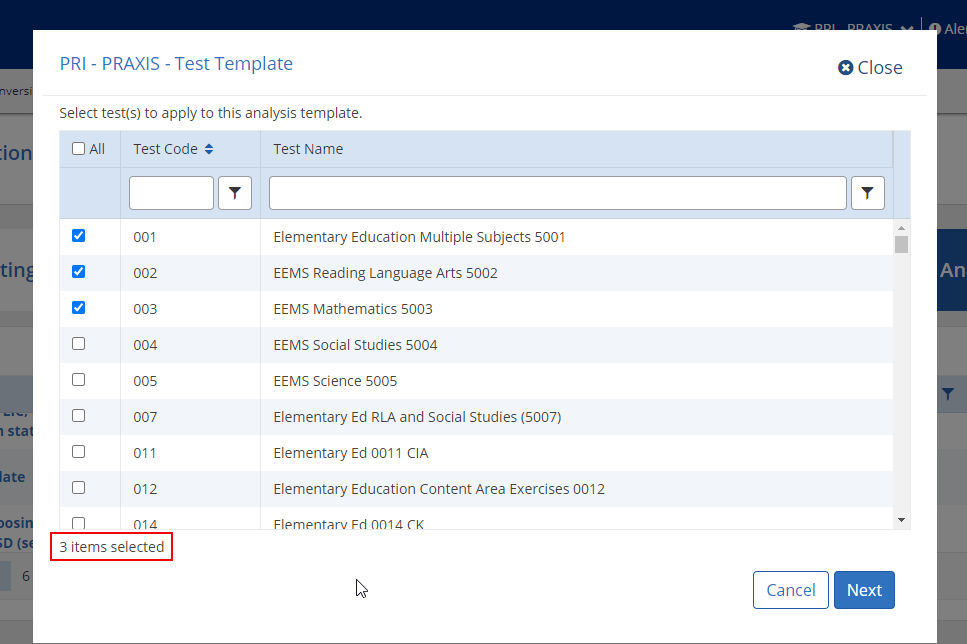

- Selecting 'Go Back' will return you to the list where you can revise your test selections.
- Selecting 'Cancel' will return you to the Analysis Templates grid without saving any changes.
- Selecting 'Save & Apply' will save and apply the selected test(s) to the template and return you to the Analysis Templates grid where the list of applied tests will be displayed under Test(s).
- If the list of the test codes becomes too long for one line, a 'See More' link will be provided to show the full list

NOTE: If a program has a new test which has not been set up in PARcore yet, PAR staff will need to enter a ServiceNow ticket to request PARcore Support to add the test in PARcore.
Enabling/Disabling an Analysis Template
Users with Super Admin or PAR Admin role for the program selected in Global Navigation will be able to disable an Enabled template or enable a Disabled template.
To disable or enable a template, under the Actions column, select ‘…More’
Note: Options will not appear for a template associated to a different program than the one selected in Global Navigation.
- If a template is Enabled, the menu action will display a ‘Disable’ button.
- If a template is Disabled, the menu action will display an ‘Enable’ button.
- Both options are available for templates in Draft or Approved status


Enabled templates:
- Available actions: View, Approve, Edit, Duplicate, Apply to Test(s), Disable , Delete.
- Available in Test Settings after tests are applied
- Available for use in Ad Hoc analysis in Analysis Planning module
Disabled templates:
- Available actions: View, Duplicate, Delete
- Not available in Test Settings
- Not available for use in Ad Hoc analysis in Analysis Planning module
Deleting an Analysis Template
Users with Super Admin or PAR Admin role for the program selected in Global Navigation will be able to delete an analysis template under the selected program.
To delete a template, under the Actions column, select ‘…More’ and then ‘Delete’
Note: Option will not appear for a template associated to a different program than the one selected in Global Navigation.
- Users can delete templates that are Approved or Draft, as well as Enabled or Disabled.
- A confirmation modal will display. Select 'Yes' to confirm deleting the template.


